DODGE DART 2013 PF / 1.G User Guide
Manufacturer: DODGE, Model Year: 2013, Model line: DART, Model: DODGE DART 2013 PF / 1.GPages: 132, PDF Size: 4.13 MB
Page 111 of 132
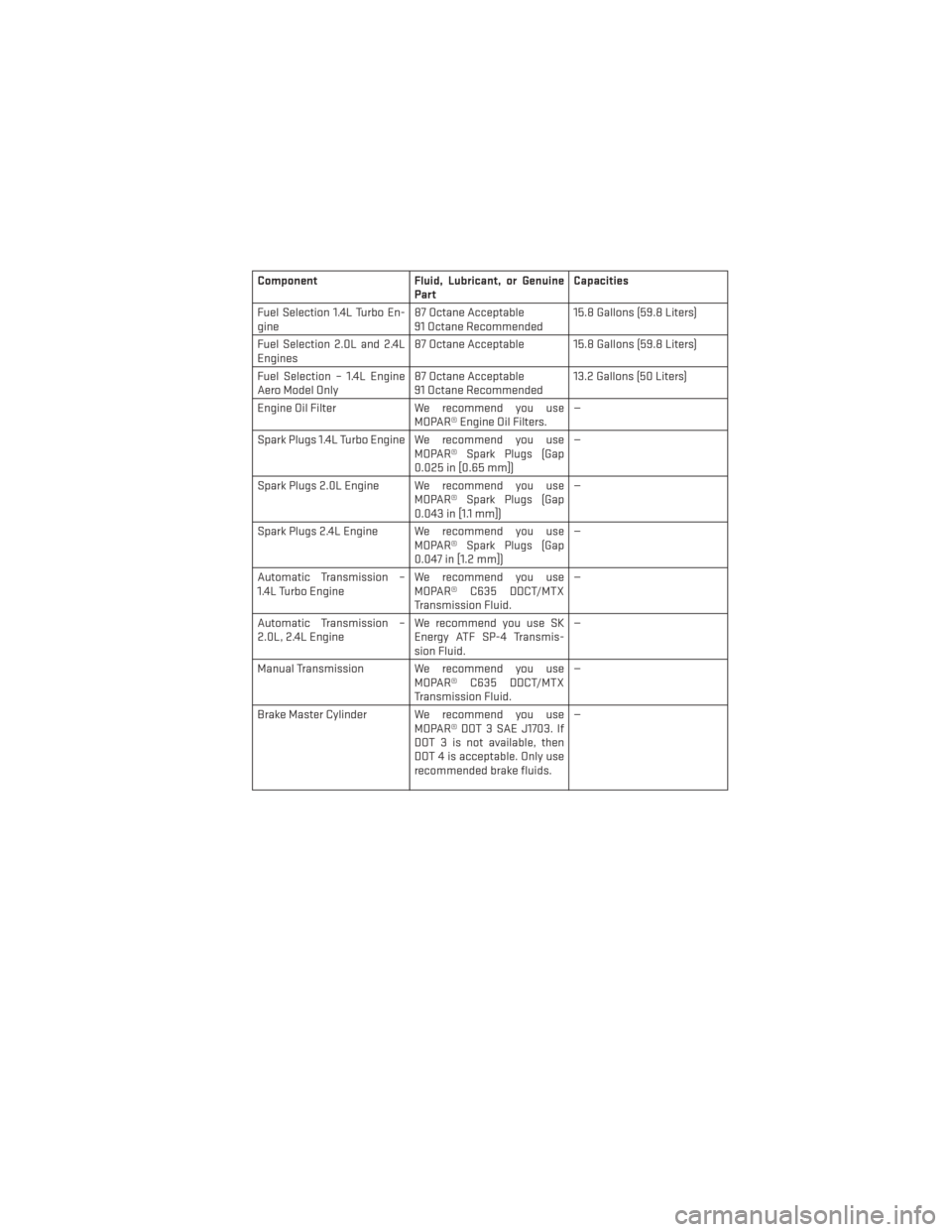
ComponentFluid, Lubricant, or Genuine
Part Capacities
Fuel Selection 1.4L Turbo En-
gine 87 Octane Acceptable
91 Octane Recommended 15.8 Gallons (59.8 Liters)
Fuel Selection 2.0L and 2.4L
Engines 87 Octane Acceptable 15.8 Gallons (59.8 Liters)
Fuel Selection – 1.4L Engine
Aero Model Only 87 Octane Acceptable
91 Octane Recommended 13.2 Gallons (50 Liters)
Engine Oil Filter We recommend you use
MOPAR® Engine Oil Filters. —
Spark Plugs 1.4L Turbo Engine We recommend you use MOPAR® Spark Plugs (Gap
0.025 in [0.65 mm]) —
Spark Plugs 2.0L Engine We recommend you use MOPAR® Spark Plugs (Gap
0.043 in [1.1 mm]) —
Spark Plugs 2.4L Engine We recommend you use MOPAR® Spark Plugs (Gap
0.047 in [1.2 mm]) —
Automatic Transmission –
1.4L Turbo Engine We recommend you use
MOPAR® C635 DDCT/MTX
Transmission Fluid. —
Automatic Transmission –
2.0L, 2.4L Engine We recommend you use SK
Energy ATF SP-4 Transmis-
sion Fluid. —
Manual Transmission We recommend you use MOPAR® C635 DDCT/MTX
Transmission Fluid. —
Brake Master Cylinder We recommend you use MOPAR® DOT 3 SAE J1703. If
DOT 3 is not available, then
DOT 4 is acceptable. Only use
recommended brake fluids. —
MAINTAINING YOUR VEHICLE
109
Page 112 of 132
CAUTION!
• Mixing of engine coolant (antifreeze) other than specified Organic Additive Technol-ogy (OAT) engine coolant (antifreeze), may result in engine damage and may de-
crease corrosion protection. Organic Additive Technology (OAT) engine coolant is
different and should not be mixed with Hybrid Organic Additive Technology (HOAT)
engine coolant (antifreeze) or any “globally compatible” coolant (antifreeze). If a
non-OAT engine coolant (antifreeze) is introduced into the cooling system in an
emergency, the cooling system will need to be drained, flushed, and refilled with
fresh OAT coolant (conforming to MS-12106), by an authorized dealer as soon as
possible.
• Do not use water alone or alcohol-based engine coolant (antifreeze) products. Do not
use additional rust inhibitors or antirust products, as they may not be compatible
with the radiator engine coolant and may plug the radiator.
• This vehicle has not been designed for use with propylene glycol-based engine
coolant (antifreeze). Use of propylene glycol-based engine coolant (antifreeze) is not
recommended.
MAINTENANCE SCHEDULE
Your vehicle is equipped with an automatic oil change indicator system. The oil change
indicator system will remind you that it is time to take your vehicle in for scheduled
maintenance.
Based on engine operation conditions, the oil change indicator message will illuminate.
This means that service is required for your vehicle. Operating conditions such as frequent
short-trips, trailer tow, extremely hot or cold ambient temperatures, and E85 fuel usage will
influence when the “Change Oil” or “Oil Change Required” message is displayed. Severe
Operating Conditions can cause the change oil message to illuminate as early as 3,500
miles (5,600 km) since last reset. Have your vehicle serviced as soon as possible, within the
next 500 miles (805 km).
NOTE:
Under no circumstances should oil change intervals exceed 10,000 miles (16,000 km) or
twelve months, whichever comes first.
MAINTAINING YOUR VEHICLE
110
Page 113 of 132
Once A Month Or Before A Long Trip:
• Check engine oil level
• Check windshield washer fluid level
• Check the tire inflation pressures and look for unusual wear or damage
• Check the fluid levels of the coolant reservoir, and brake master cylinder as needed
• Check function of all interior and exterior lights
Required Maintenance Intervals.
Refer to the maintenance schedules on the following page for the required maintenance.
At Every Oil Change Interval As Indicated By Oil Change Indicator System:
Change oil and filter
Rotate the tires.Rotate at the first sign of irregular wear, even if it occurs before the oil
indicator system turns on.
Inspect battery and clean and tighten terminals as required
Inspect brake pads, shoes, rotors, drums, hoses and park brake
Inspect engine cooling system protection and hoses
Inspect exhaust system
Inspect engine air cleaner if using in dusty or off-road conditions
MAINTAINING YOUR VEHICLE
111
Page 114 of 132
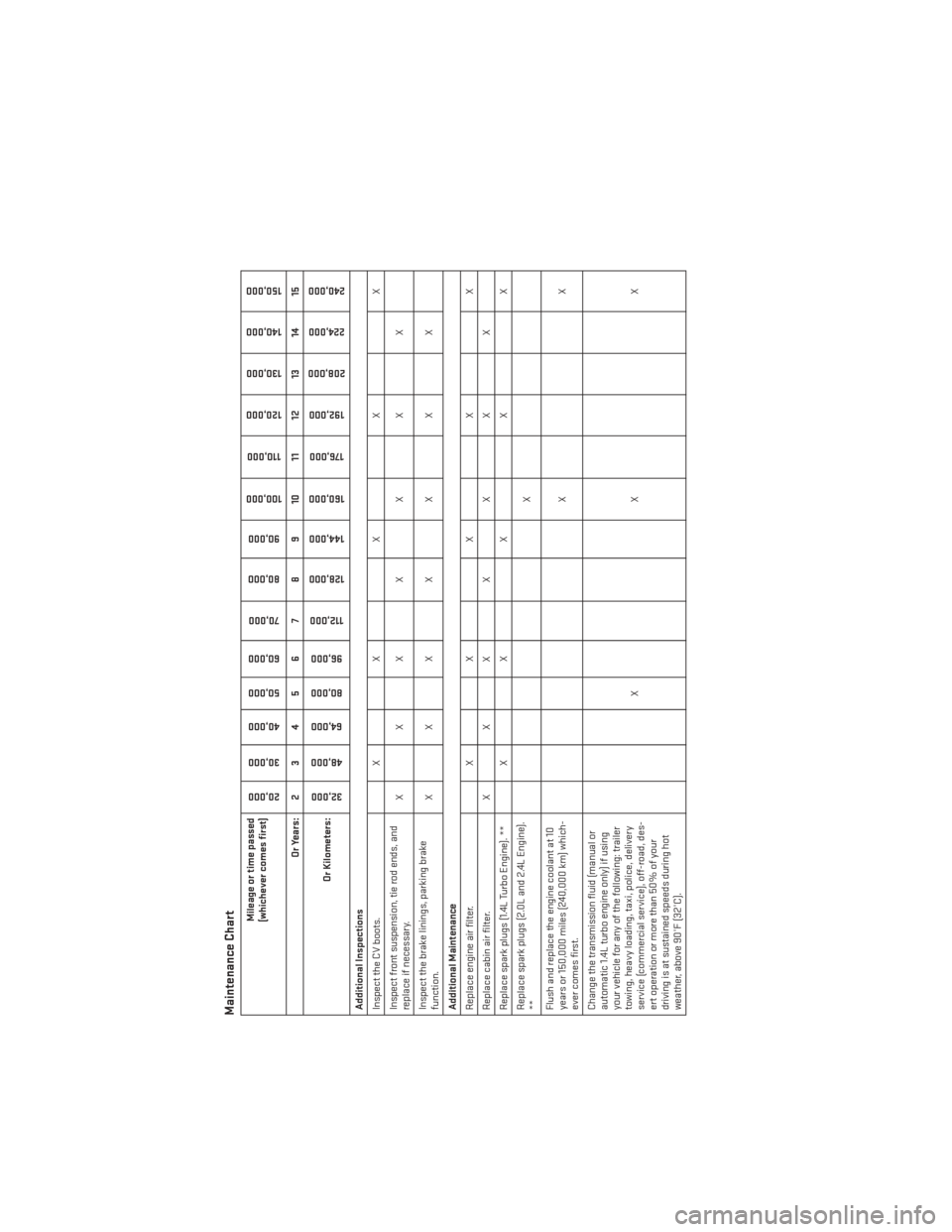
Maintenance Chart
Mileage or time passed
(whichever comes first)
20,000
30,000
40,000
50,000
60,000
70,000
80,000 90,000
100,000
110,000
120,000 130,000
140,000
150,000
Or Years: 2 3 4 5 6 7 8 9 10 11 12 13 14 15
Or Kilometers:
32,000
48,000
64,000
80,000
96,000
112,000
128,000 144,000
160,000
176,000
192,000
208,000
224,000
240,000
Additional Inspections
Inspect the CV boots. X X X X X
Inspect front suspension, tie rod ends, and
replace if necessary. XXX X X X X
Inspect the brake linings, parking brake
function. XXX X X X X
Additional Maintenance
Replace engine air filter. X X X X X
Replace cabin air filter. X X X X X X X
Replace spark plugs (1.4L Turbo Engine). ** X X X X X
Replace spark plugs (2.0L and 2.4L Engine).
** X
Flush and replace the engine coolant at 10
years or 150,000 miles (240,000 km) which-
ever comes first. XX
Change the transmission fluid (manual or
automatic 1.4L turbo engine only) if using
your vehicle for any of the following: trailer
towing, heavy loading, taxi, police, delivery
service (commercial service), off-road, des-
ert operation or more than 50% of your
driving is at sustained speeds during hot
weather, above 90°F (32°C). XX X
MAINTAINING YOUR VEHICLE
112
Page 115 of 132
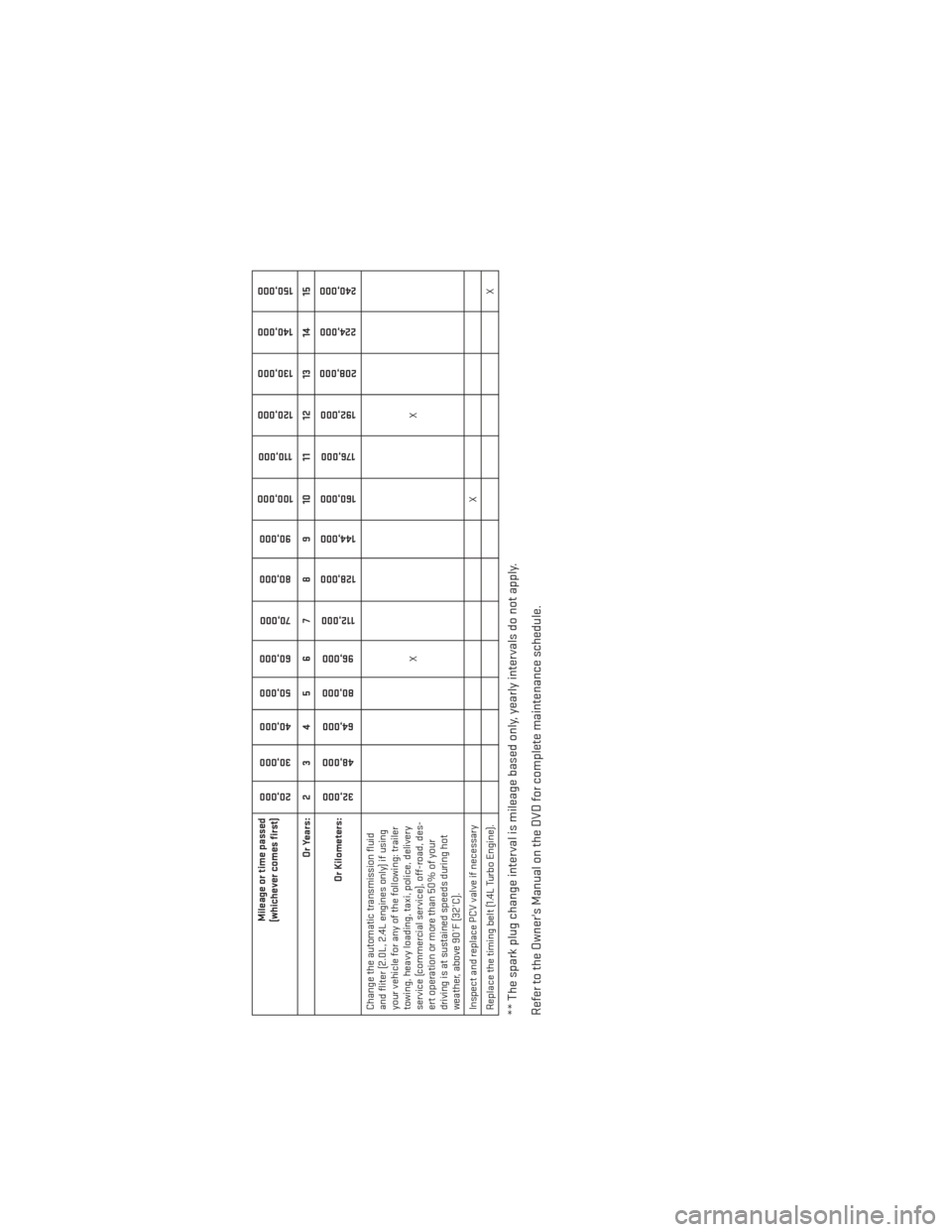
Mileage or time passed
(whichever comes first)
20,000
30,000
40,000
50,000
60,000
70,000
80,000 90,000
100,000
110,000
120,000 130,000
140,000
150,000
Or Years: 2 3 4 5 6 7 8 9 10 11 12 13 14 15
Or Kilometers:
32,000
48,000
64,000
80,000
96,000
112,000
128,000 144,000
160,000
176,000
192,000
208,000
224,000
240,000
Change the automatic transmission fluid
and fliter (2.0L, 2.4L engines only) if using
your vehicle for any of the following: trailer
towing, heavy loading, taxi, police, delivery
service (commercial service), off-road, des-
ert operation or more than 50% of your
driving is at sustained speeds during hot
weather, above 90°F (32°C). XX
Inspect and replace PCV valve if necessary X
Replace the timing belt (1.4L Turbo Engine). X** The spark plug change interval is mileage based only, yearly intervals do not apply.
Refer to the Owner's Manual on the DVD for complete maintenance schedule.
MAINTAINING YOUR VEHICLE
113
Page 116 of 132
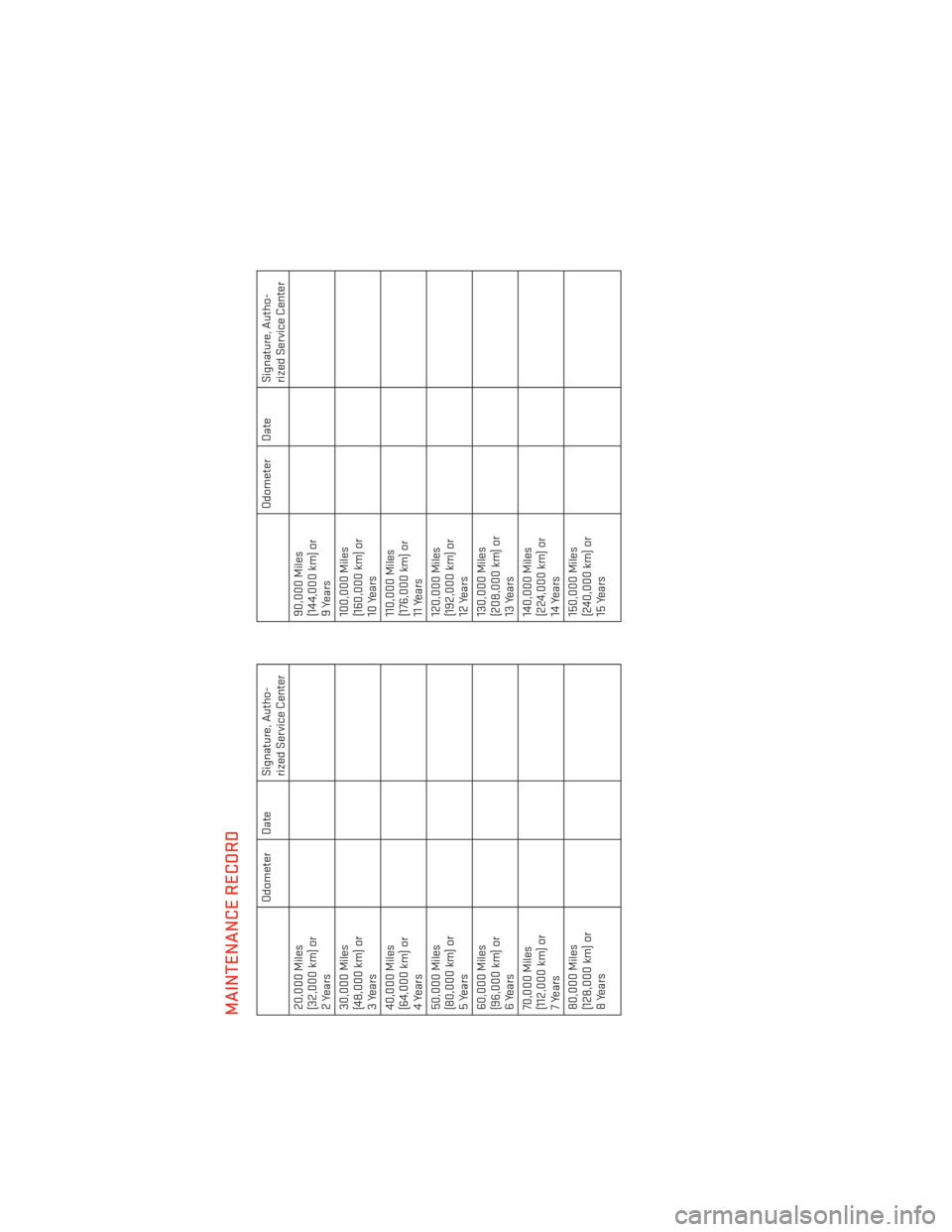
MAINTENANCE RECORD
Odometer Date Signature, Autho-rized Service Center
20,000 Miles
(32,000 km) or
2Years
30,000 Miles
(48,000 km) or
3Years
40,000 Miles
(64,000 km) or
4 Years
50,000 Miles
(80,000 km) or
5Years
60,000 Miles
(96,000 km) or
6 Years
70,000 Miles
(112,000 km) or
7 Years
80,000 Miles
(128,000 km) or
8Years
Odometer Date Signature, Autho- rized Service Center
90,000 Miles
(144,000 km) or
9 Years
100,000 Miles
(160,000 km) or
10 Years
110,000 Miles
(176,000 km) or
11 Years
120,000 Miles
(192,000 km) or
12 Years
130,000 Miles
(208,000 km) or
13 Years
140,000 Miles
(224,000 km) or
14 Years
150,000 Miles
(240,000 km) or
15 Years
MAINTAINING YOUR VEHICLE
114
Page 117 of 132
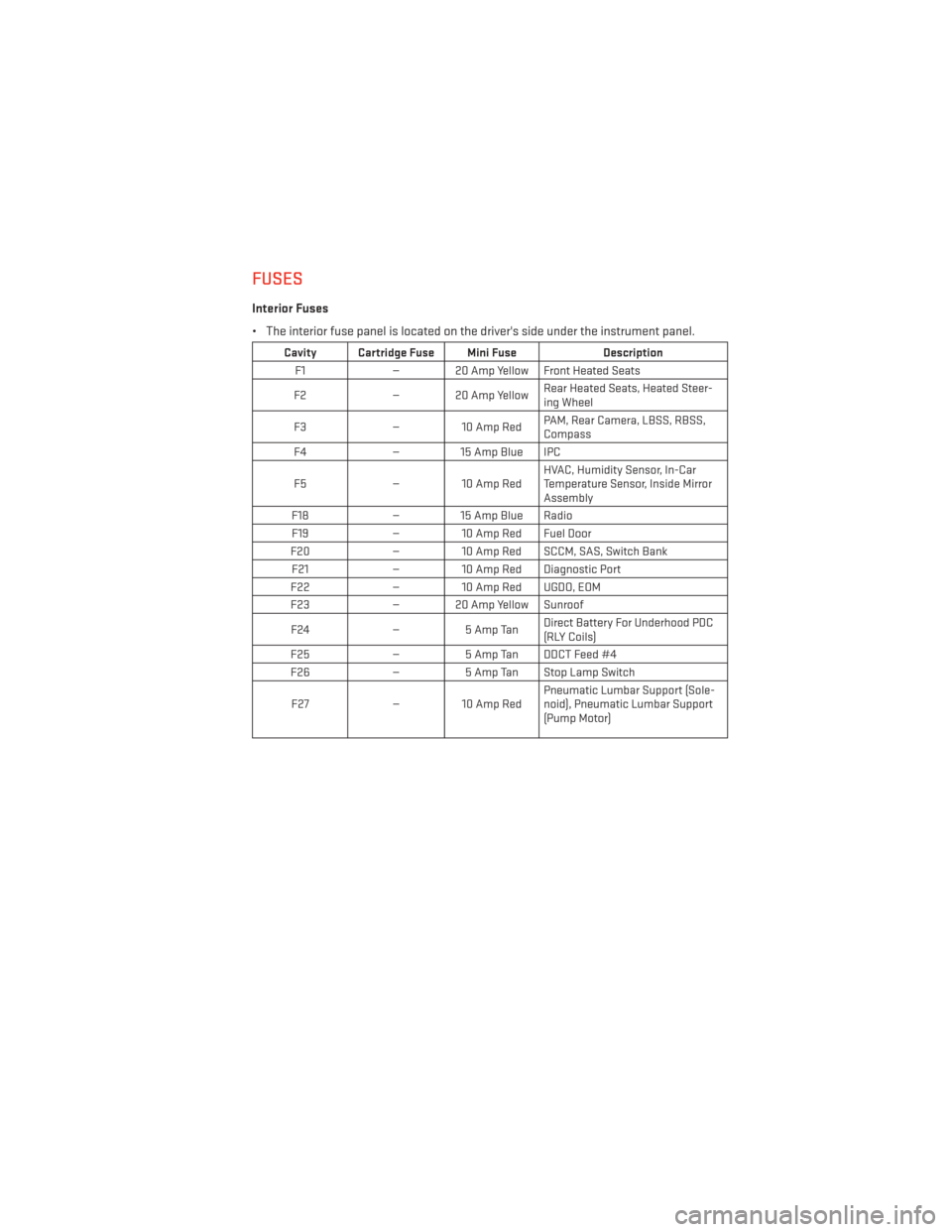
FUSES
Interior Fuses
• The interior fuse panel is located on the driver's side under the instrument panel.
Cavity Cartridge Fuse Mini FuseDescription
F1 — 20 Amp Yellow Front Heated Seats
F2 — 20 Amp Yellow Rear Heated Seats, Heated Steer-
ing Wheel
F3 — 10 Amp Red PAM, Rear Camera, LBSS, RBSS,
Compass
F4 — 15 Amp Blue IPC
F5 — 10 Amp Red HVAC, Humidity Sensor, In-Car
Temperature Sensor, Inside Mirror
Assembly
F18 — 15 Amp Blue Radio
F19 — 10 Amp Red Fuel Door
F20 — 10 Amp Red SCCM, SAS, Switch Bank
F21 — 10 Amp Red Diagnostic Port
F22 — 10 Amp Red UGDO, EOM
F23 — 20 Amp Yellow Sunroof
F24 —5 Amp Tan Direct Battery For Underhood PDC
(RLY Coils)
F25 —5 Amp Tan DDCT Feed #4
F26 —5 Amp Tan Stop Lamp Switch
F27 — 10 Amp Red Pneumatic Lumbar Support (Sole-
noid), Pneumatic Lumbar Support
(Pump Motor)
MAINTAINING YOUR VEHICLE
115
Page 118 of 132
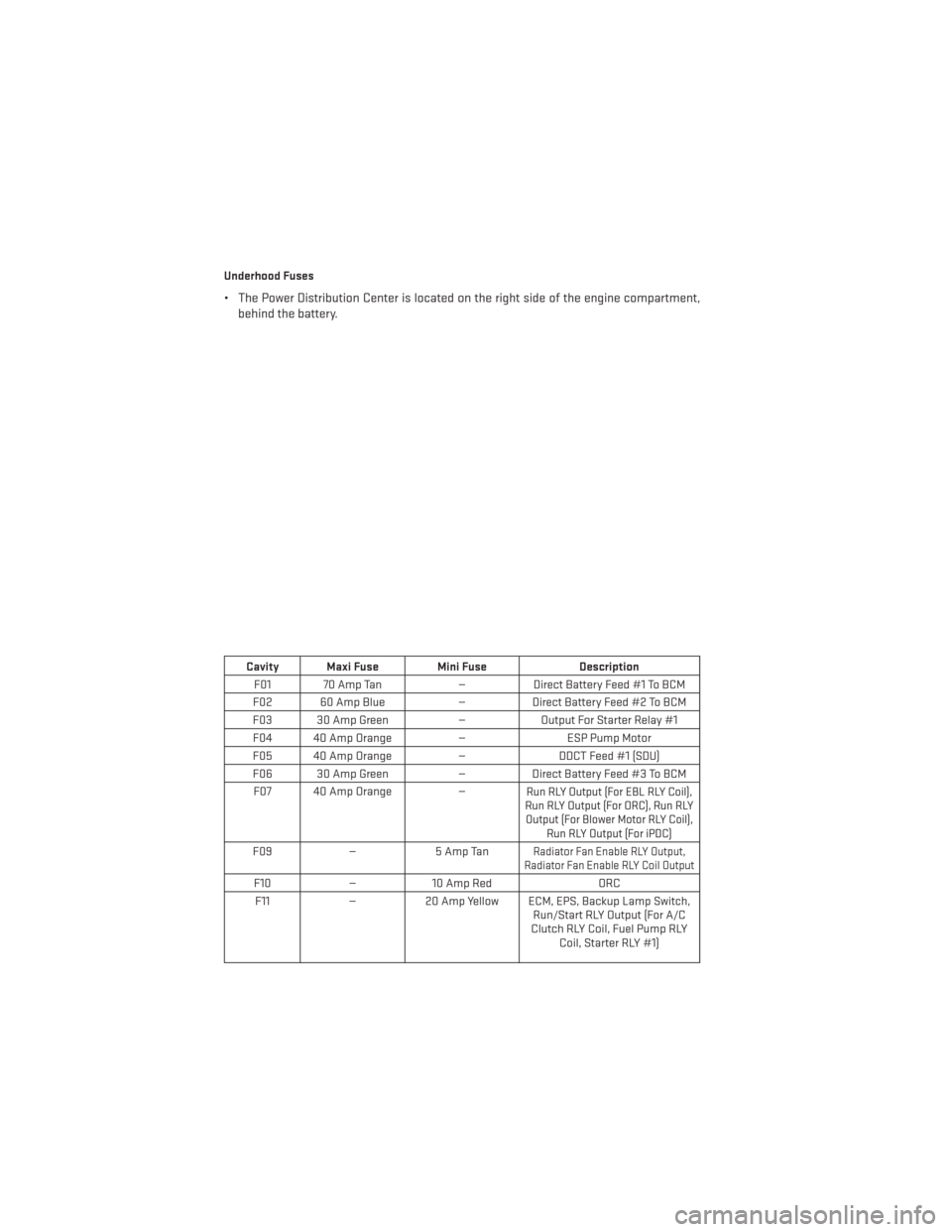
Underhood Fuses
• The Power Distribution Center is located on the right side of the engine compartment,behind the battery.
Cavity Maxi Fuse Mini Fuse Description
F01 70 Amp Tan —Direct Battery Feed #1 To BCM
F02 60 Amp Blue —Direct Battery Feed #2 To BCM
F03 30 Amp Green —Output For Starter Relay #1
F04 40 Amp Orange —ESP Pump Motor
F05 40 Amp Orange —DDCT Feed #1 (SDU)
F06 30 Amp Green —Direct Battery Feed #3 To BCM
F07 40 Amp Orange —
Run RLY Output (For EBL RLY Coil),
Run RLY Output (For ORC), Run RLY Output (For Blower Motor RLY Coil), Run RLY Output (For iPDC)
F09 —5 Amp TanRadiator Fan Enable RLY Output,
Radiator Fan Enable RLY Coil Output
F10 —10 Amp Red ORC
F11 —20 Amp Yellow ECM, EPS, Backup Lamp Switch,
Run/Start RLY Output (For A/C
Clutch RLY Coil, Fuel Pump RLY Coil, Starter RLY #1)
MAINTAINING YOUR VEHICLE
116
Page 119 of 132
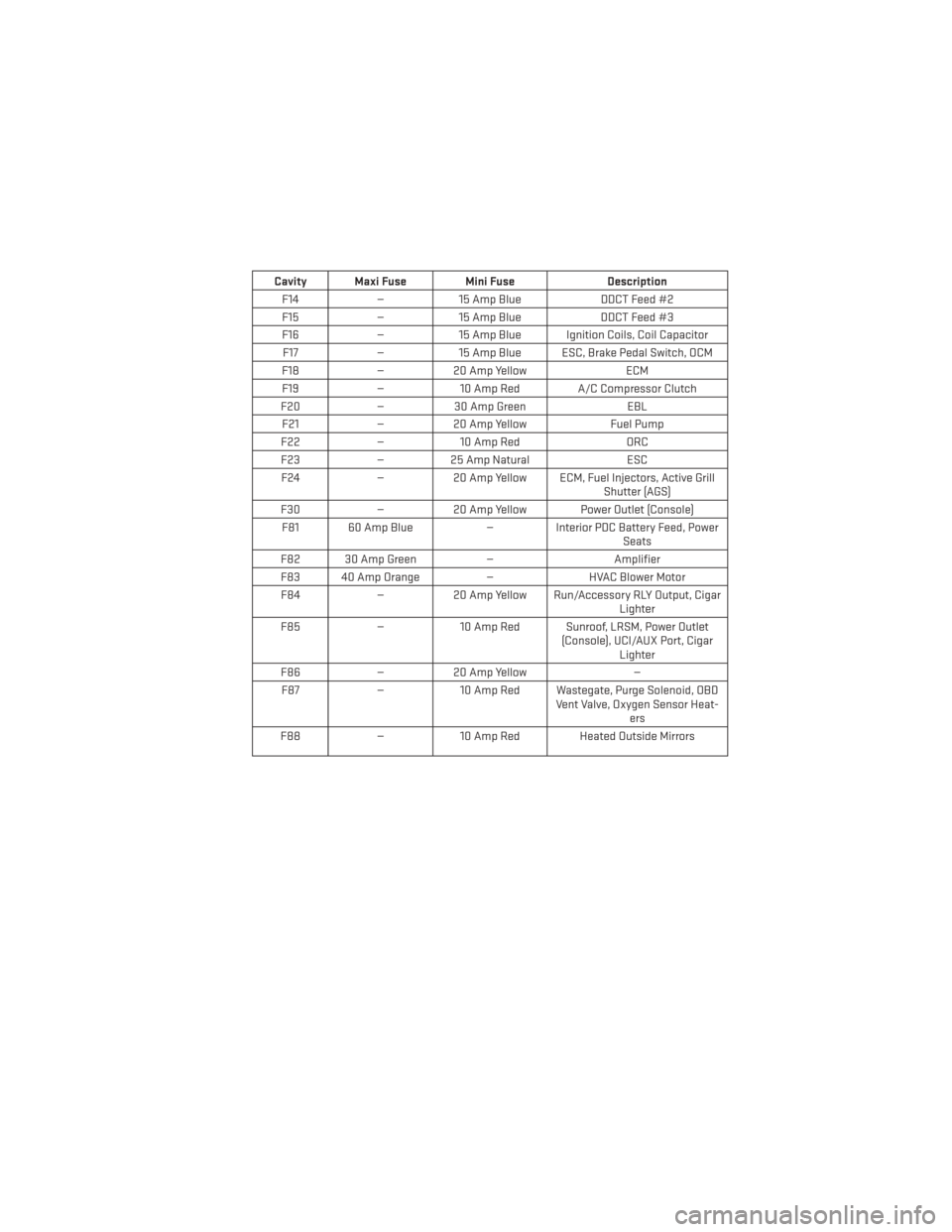
Cavity Maxi Fuse Mini FuseDescription
F14 —15 Amp Blue DDCT Feed #2
F15 —15 Amp Blue DDCT Feed #3
F16 —15 Amp Blue Ignition Coils, Coil Capacitor
F17 —15 Amp Blue ESC, Brake Pedal Switch, OCM
F18 —20 Amp Yellow ECM
F19 —10 Amp Red A/C Compressor Clutch
F20 —30 Amp Green EBL
F21 —20 Amp Yellow Fuel Pump
F22 —10 Amp Red ORC
F23 —25 Amp Natural ESC
F24 —20 Amp Yellow ECM, Fuel Injectors, Active Grill
Shutter (AGS)
F30 —20 Amp Yellow Power Outlet (Console)
F81 60 Amp Blue —Interior PDC Battery Feed, Power
Seats
F82 30 Amp Green —Amplifier
F83 40 Amp Orange —HVAC Blower Motor
F84 —20 Amp Yellow Run/Accessory RLY Output, Cigar
Lighter
F85 —10 Amp Red Sunroof, LRSM, Power Outlet
(Console), UCI/AUX Port, CigarLighter
F86 —20 Amp Yellow —
F87 —10 Amp Red Wastegate, Purge Solenoid, OBD
Vent Valve, Oxygen Sensor Heat-ers
F88 —10 Amp Red Heated Outside Mirrors
MAINTAINING YOUR VEHICLE
117
Page 120 of 132
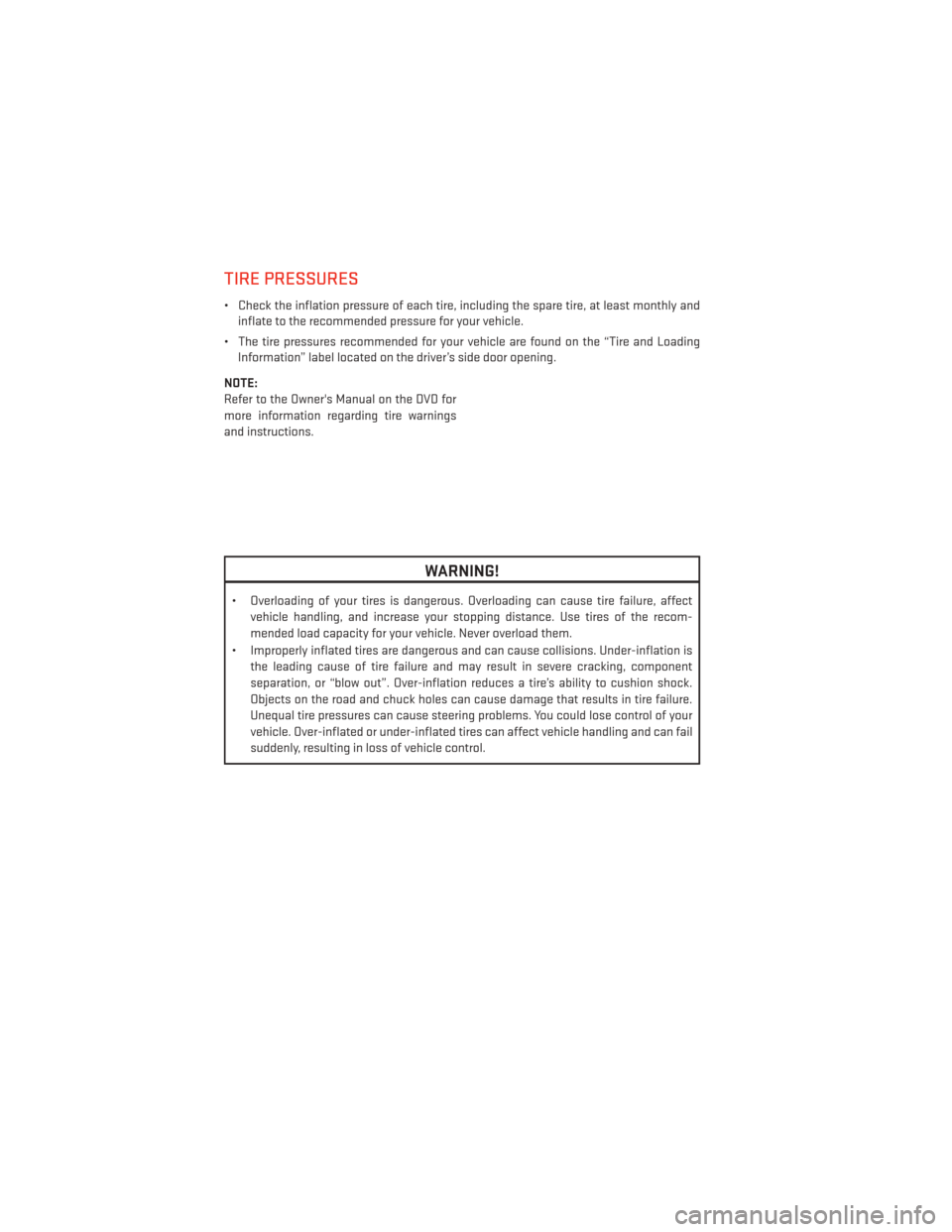
TIRE PRESSURES
• Check the inflation pressure of each tire, including the spare tire, at least monthly andinflate to the recommended pressure for your vehicle.
• The tire pressures recommended for your vehicle are found on the “Tire and Loading Information” label located on the driver’s side door opening.
NOTE:
Refer to the Owner's Manual on the DVD for
more information regarding tire warnings
and instructions.
WARNING!
• Overloading of your tires is dangerous. Overloading can cause tire failure, affect vehicle handling, and increase your stopping distance. Use tires of the recom-
mended load capacity for your vehicle. Never overload them.
• Improperly inflated tires are dangerous and can cause collisions. Under-inflation is the leading cause of tire failure and may result in severe cracking, component
separation, or “blow out”. Over-inflation reduces a tire’s ability to cushion shock.
Objects on the road and chuck holes can cause damage that results in tire failure.
Unequal tire pressures can cause steering problems. You could lose control of your
vehicle. Over-inflated or under-inflated tires can affect vehicle handling and can fail
suddenly, resulting in loss of vehicle control.
MAINTAINING YOUR VEHICLE
118